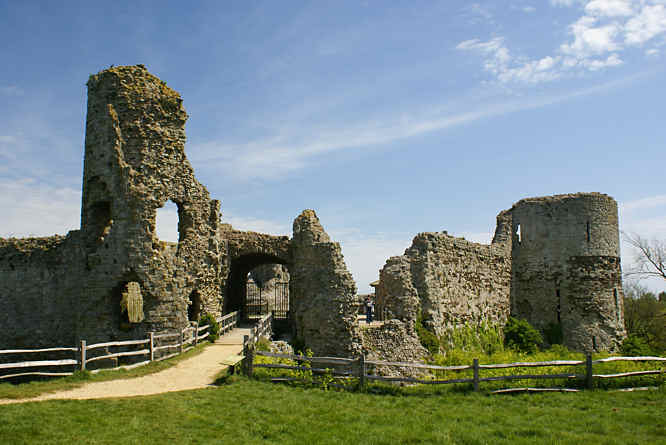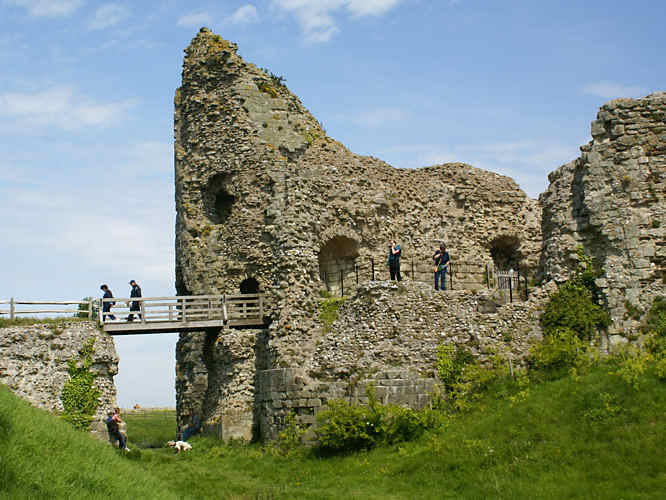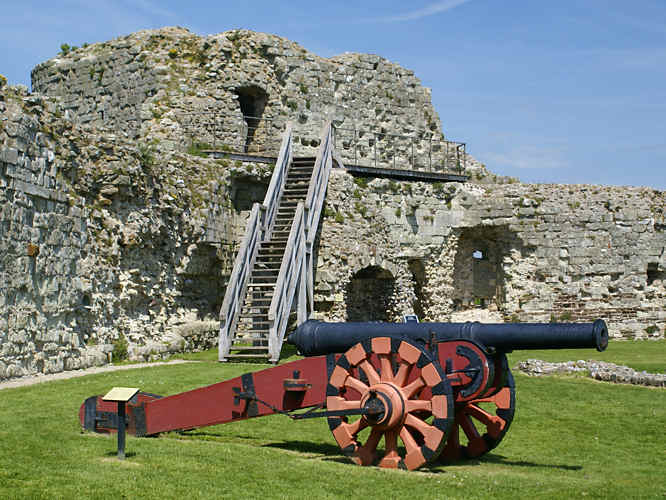1066 Pevensey Castle
Take the train or bus from Eastbourne to the small seaside town of Pevensea. This historic castle is about 10 minutes walk away inland. You can see it from the railway station. The roughly oval plan of Pevensey Castle dates from Roman times, and evidence of this period can still be seen in the remains of the rectangular gatehouse and a small postern in the northwest wall.

Roman Pevensey Castle
The old Roman ditches and mounds around the site are still visible. Pevensey Castle is unusual as most Roman forts favoured a rectangular layout. It's shape reflected its position at the tip of a peninsular of high ground and when it was built, surrounded by sea and marshland. It protected beached navel vessels and had a garrison of 300 to 600.
It was built in the mid 290s by Allectus, a follower of Carausius, a rebellious naval officer who proclaimed himself an independent emperor in the province of Britannia. Carausius was assassinated by Allectus in 293, and it wasn't until 296 that Rome regained control of Britannia when Constantine re invaded the country. The fortifications were increased and Pevensey Castle was now used to defend Roman Britain from the sea borne raiding attacks by Anglo-Saxons, Jutes and Frisians. It was one of the biggest fort in the salon Shore defensive chain

When Pevensey Castle was occupied by the Romans the sea came right up to one of the walls, although the sea has since retreated and is now approximately three miles away. Remarkably, the walls of Pevensey Castle have remained in a relatively good state of preservation, providing a good indication of the layout and structure of the castle buildings. Although some of the early earthwork defences were subsequently replaced by structural fortifications.
Saxon Pevensey Castle
The Romans left Britain 410AD. In 491 AD, after some years of fighting, Pevensey castle was conquered by the Saxon warlord Aelle and the area became settled. In due course, the area became part of the Royal Estates, under King Alfred. The name Eastbourne itself derives from Anglo-Saxon, being a variant of the Middle English for small stream.
Norman Pevensey Castle
William the Conqueror invaded England on 28th September 1066. Landing with his army at Pevensey, and quickly threw up a defensive structure inside the fortifications he found at Pevensey. William the French speak Viking from Normandy (land of the North-Men in Northern france settled by Vikings), then made for Hastings and dug in there while he waited to face the Saxon King Harold. In the years following the Conquest, a formidable stone castle was built by the Normans at Pevensey, much of which survives today Pevensey castle is in fact depicted in one of the early scenes in the Bayeux Tapestry.

Robert of Mortain (half brother to William the Conqueror), was granted Pevensey Castle shortly after the Norman Conquest. De Mortain used the existing fort, which had laid derelict for over 600 years, as the base for building his castle, carrying out only minor repairs to the walls forming the outer bailey, and building a new inner bailey at the eastern end.
A new gateway replaced the original main entrance to the southwest, and the east gateway was repaired. Other alterations made were mainly additions and improvement to existing structures within the original fort. An irregular, rectangular-shaped enclosure was created using part of the Roman wall and two bastions on the southeastern side. Shortly after the inner bailey was created, the rectangular stone keep was erected, incorporating part of the east curtain wall and a Roman bastion. Some time later, three more bastions facing the inner bailey were added to the keep.
Civil War Pevensey Castle
In 1147 Pevensey castle was used by the Earl of Pembroke in his unsuccessful rebellion against King Stephen. Then in 1264 supporters of Henry the Third held out in Pevensey Castle following defeat by rebels led by Simon de Montfort at the Battle of Lewes. They remained there until de Montfort's defeat at the Battle of Evesham in August the following year. Finally in 1399 the Constable of Pevensey Castle, Sir John Pelham, joined Henry Bollingbroke in his ultimately successful rebellion against Richard the Second. While Sir John was away fighting alongside Henry, his wife, Lady Joan Pelham rallied the garrison at Pevensey Castle and managed to hold out against a prolonged siege by Richard the Second's troops.
Later in history the castle was modernised and strengthened once again, to face the threat of a Spanish invasion and the Armada in 1588. Then during 1940 when invasion by Germany seemed imminent gun emplacements and machine gun posts were built into the walls of the castle. This extensive site, situated on the gentle Sussex coast, is a fascinating insight into two very distinct periods of building that were brought together to create a strong, medieval fortress.
Following a long and turbulent history, Pevensey Castle was left uninhabited by the 16th century, and fell into a ruinous state, despite a brief period where it was reinstated for defence purposes with the threat of the Spanish Armada. From that time, Pevensey Castle passed through a succession of owners until finally it came into the possession of the Duke of Devonshire who, in 1925, presented it to the State.
Book your accommodation in Eastbourne with Amazon.co.uk Destinations

Click here to find accommodation in Eastbourne